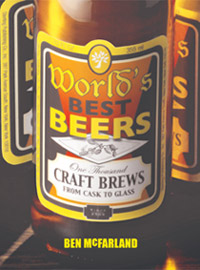Last week Joe Stange blogged about The Mythology of Glassware. Perhaps that’s why Gourmet moved a very long story about Riedel glassware to the free section of its archives. It’s titled “Shattered Myths” so I don’t think I’m spoiling the punchline when I quote from the end:
Georg Riedel finally seemed to be vindicated when media around the world trumpeted the results of a study conducted at the University of Tennessee. “A U.S. study found that the shape of a glass can have a big influence on chemicals in wine,” the London-based Daily Telegraph glowed, in August 2002. “Wine really does taste different depending on the kind of glass it is drunk from, according to research.”
“Scientists prove the right glass matters,” declared Decanter magazine. “It’s official—wine really does taste better out of the right glass.” The findings were cited by everyone from New Scientist magazine to American radio legend Paul Harvey. Riedel himself must have been relieved. “It is great,” he told a reporter, “that independent scientific research supports our philosophy.”
But when I tracked down the researcher who did the study, she groaned. Then she started laughing. “I can’t believe how reporters ran away with this thing,” says Kari Russell. “That’s because so many people want to believe” that glasses make a difference. First of all, Russell is bemused that nobody seemed to realize that she wasn’t a renowned scientist, but a mere college senior (she’s now working on a Ph.D.). And she didn’t do some big, rigorous study: She rounded up just a dozen subjects.
And what she finds even more bizarre, she says, is that Riedel wouldn’t have liked her findings if anybody had reported them correctly, because they don’t support his claims at all. “Glass shape does not affect the perceptions of the average consumer,” Russell told me. “That’s my conclusion.” To put it bluntly, her subjects couldn’t tell the difference between Merlot in Champagne, red-wine, or Martini glasses.
Now to terroir. This just in from the annual meeting of the Geological Society of America:
When it comes to theories about terroir (how soil, weather conditions, landforms and other local circumstances define the character of wine), scientists believe we know less than we think. They now say the belief that minerals could influence the flavor of wine is flawed, considering that the quantity of minerals in wine is so small that it can’t be detected through human taste and smell. On the other hand, geologists said the soil’s water holding capacity can have an influence on the wine taste, but this notion has barely been researched.
Perhaps not quite myth busting, given that terroirists argue there’s much more to expressing place than the mineral flavors in wine, but that’s the dirt on dirt.
For the record, we like wine in our house and we like our glassware (for beer and wine). I might have mentioned that anyway, but this post by Eric Asimov sealed the deal:
The irony is that great beer and great wine are on the same team. The enemy of beer is not wine and the enemy of wine is not beer, just as the enemy of bread is not fruit and vice versa. But the enemy of good beer and good wine, and good food in general, is bad beer, bad wine and, yes, bad food.
What unites this team is the striving for real wine, real beer, and real food, as opposed to cynical product. That is the problem, and I think most people realize this no matter what they say or do. Craft beer’s battle is not against wine but against decades of cynical marketing from the giant breweries, which have done everything possible to portray beer drinkers as asinine fools. The enemy of good wine is the atrocious marketing that makes wine an aspirational commodity, just another luxury good to purchase for its status value. That has to offend the reverse snob in all of us.
Fellow wine lovers, fellow beer lovers, unite! We shall not permit ourselves to be pitted against one another. Do not be fooled by false choices. You do not have to choose beer or wine. Just good or bad.
Somebody writing for the New York Times doesn’t need a link from here, but I feel a need to add the obvious: we don’t need to see beer following wine down the aspirational path.
